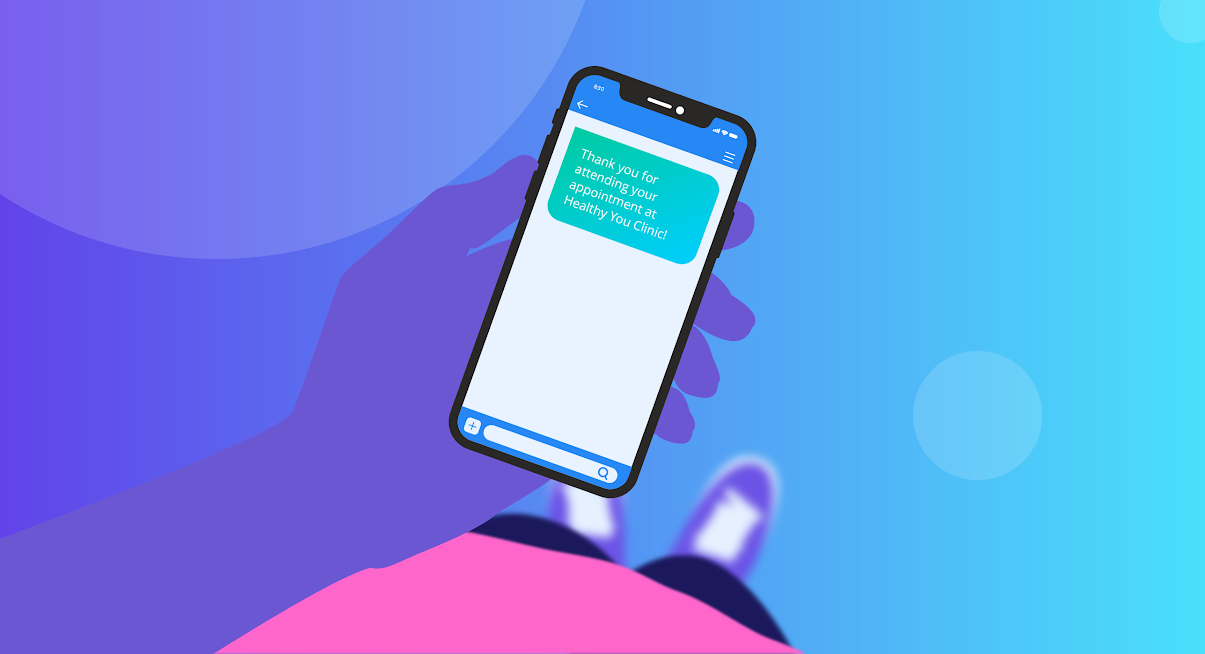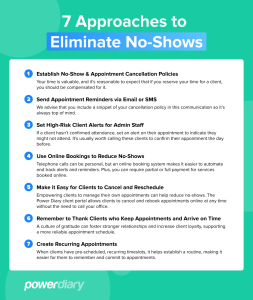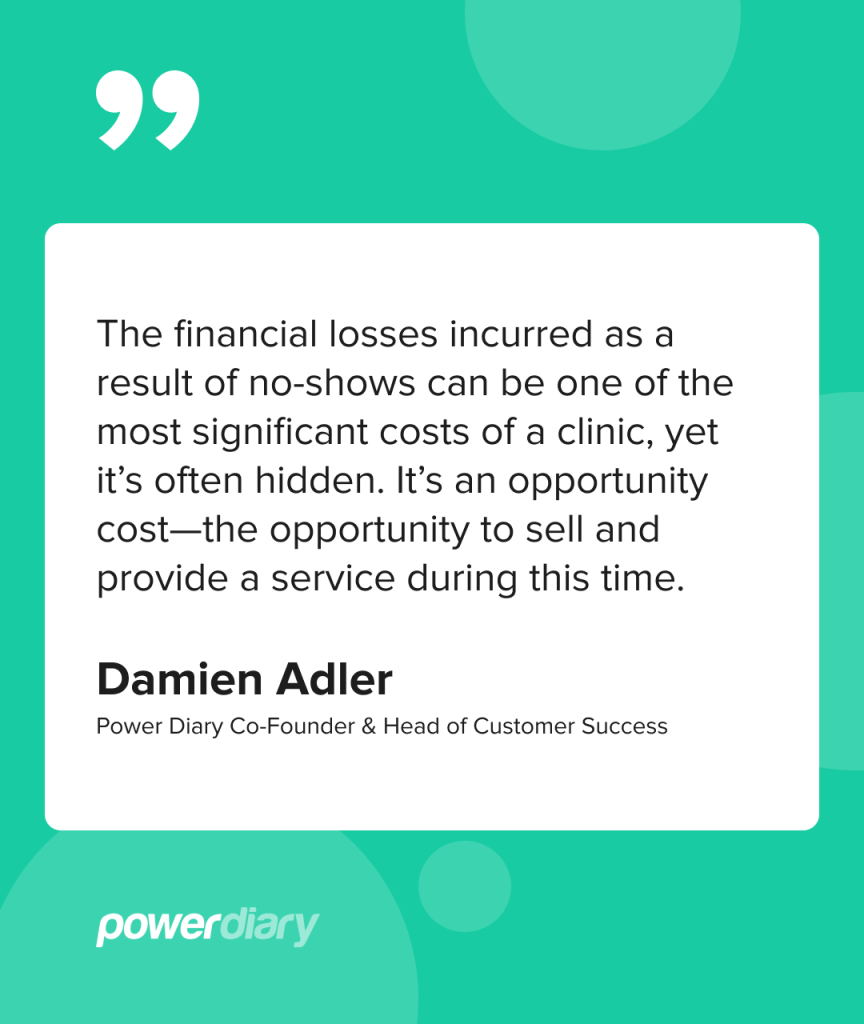No-shows are one of the most frustrating (and costly!) aspects of running a practice, and multiple layers of your business feel the effects. But if you tighten up your processes and use practice management software, you’ll be well on your way to eliminating no-shows in your practice.
In this article, we’ll discuss seven strategic approaches to integrate into your daily routine to mitigate the impacts of no-shows.
How Do No-Shows Affect Your Practice?
When thinking about no-shows, most of us understandably consider the immediate financial implications. However, the truth is that clients failing to attend appointments has a holistically negative impact on your business.
“The financial losses incurred as a result of no-shows can be one of the most significant costs of a clinic, yet it’s often hidden. It’s an opportunity cost – the opportunity to sell and provide a service during this time.”
Damien Adler, Power Diary Co-Founder and Head of Customer Success
Other impacts include:
- You and your team have less time to provide healthcare services to members of your community. A missed appointment is a wasted opportunity. Furthermore, by the time you know a no-show client isn’t coming and you’ve tried to get in touch with them, a significant amount of time has been lost.
- Your team’s morale may be negatively impacted, and it can be difficult to refocus when there’s a lull in your day.
- If no-shows run unchecked, clients will stop valuing your and your team’s time. Treatment may become a low priority for your clients, and no-shows will likely become more common.
Therefore, being clear about your boundaries from day one is essential.
7 Approaches to Eliminate No-Shows
Streamline your workflows to eliminate no-shows.
Here are some simple tips:
1. No-Show & Appointment Cancellation Policies
It’s crucial to change your mindset. When clients book an appointment, they enter a financial agreement. Your time is valuable and perishable, and it’s reasonable to expect that if you reserve your time for a client, you should be compensated for it.
Therefore, writing and implementing a detailed cancellation policy is essential from day one. You can always waive your policies under exceptional circumstances if the client has a reasonable or urgent reason for missing their appointment.
Use the online form function in Power Diary to set up a cancellation agreement policy to send clients upon booking. You can also display the cancellation agreement using signage in your waiting room, mention it verbally during your first appointment and even add it to your website.
If an appointment is booked via phone instead of online, you should have a brief script ready so that all clients are informed of the policy.
2. Appointment Reminders through Email and SMS
Configure email and SMS reminders in Power Diary to ensure clients receive automatic reminders after booking appointments. We advise that you include a snippet of your cancellation policy in this communication so it’s always top of mind.
Here’s an example:
“Please note that our practice has a 48-hour notice cancellation policy. After that time has lapsed, any cancellations will be charged a 100% cancellation fee. Our full cancellation policy will be sent via email.”
Or if you need something shorter for SMS:
“Please note: Fees apply for late cancellation.”
When you use the Power Diary calendar, all client communication about an appointment will be visible when you click on it.
3. Setting High-Risk Client Alerts for Admin Staff
Encourage clients to respond to reminder messages to confirm their appointments. If they haven’t confirmed, you can set an alert on their appointment to indicate they might not attend. Furthermore, you can set the same alert if the client is a regular no-show. It’s usually worth calling these clients to confirm their appointment the day before.
4. Using Online Bookings to Reduce No-Shows
Telephone calls can be personal, but an online booking system makes automating and tracking alerts and reminders easier.
If clients call you on the go, they may fail to write down the appointment or write it on an odd piece of paper, which can easily be forgotten. An online booking system is neat and trackable and can be shared with all staff members in and out of the office, bringing you all onto the same page.
Plus, with online bookings, clients can pay at the time of booking, which can dramatically reduce no-shows. You can require partial or full payment for services booked online.
5. Make it Easy for Clients to Cancel and Reschedule
Empowering clients to manage their own appointments is another way to reduce no-shows. The Power Diary client portal allows clients to cancel and rebook appointments online without needing to call your office.
This flexibility helps prevent last-minute cancellations and no-shows by allowing clients to adjust their schedules in advance.
The portal is designed to be user-friendly, ensuring that even clients who aren’t tech-savvy can navigate it easily.
6. Remember to Thank Clients who Keep Appointments and Arrive on Time
Implement a system of personalized thank-you messages by sending quick, automated thank-you notes via email or SMS after a client attends an appointment. This shows appreciation and reinforces attendance.
This is a simple yet effective strategy to encourage punctuality and reduce no-shows. A culture of gratitude can foster stronger relationships and increase client loyalty, supporting a more reliable appointment schedule.
7. Create Recurring Appointments
Setting up recurring appointments is an excellent strategy for ensuring consistent care and reducing the frequency of no-shows. When clients have pre-scheduled, recurring timeslots, it helps establish a routine, making it easier for them to remember and commit to appointments.
This feature is particularly beneficial for treatment plans that require regular sessions, such as physical therapy, mental health counseling or occupational therapy. By scheduling these appointments in advance for the entire duration of the treatment, you secure the client’s commitment and streamline your calendar management.
Payment Collection for Missed Appointments
One of the most efficient payment collection methods is storing your client’s card details in Power Diary (with permission) and then debiting the card in the case of a no-show.
Alternatively, you can add an alert on your client’s profile to indicate they owe a ‘no-show fee’ that you can collect on their next appointment.
Power Diary also includes invoicing automations, which allow you to send payment reminders for unpaid invoices automatically.
How Automating Tasks with Power Diary Tools Can Help
Power Diary has features baked into the software to help prevent no-shows in your practice, like:
Online Bookings
According to a survey, 70% of people are more likely to book an appointment if there’s an online booking option.
Our online booking feature will take your practice to the next level. Telephone calls are becoming obsolete, with more people turning to text and emails to respond on the run. Online bookings cut out the back-and-forth, and they help avoid confusion.
Furthermore, online booking is available 24/7 in our client portal, making it incredibly convenient.
Appointment Reminders & Waitlist Features
Our practice management software has SMS and email features to remind clients about appointments. And, you can set up a waitlist for clients looking to see a specific clinician. Use the waitlist to fill last-minute openings and reduce gaps in your calendar.
These tools help to eliminate no-shows, and they keep your customers in the know. Using the latest booking technology is a great way to keep your practice looking professional.
What Makes These Tools So Powerful?
Power Diary is designed to streamline your allied healthcare practice. All your appointments and client information are in one place, reducing no-shows and keeping your team on top of the day-to-day.
In Conclusion
Whether yours is a new or existing practice, it’s important to establish a professional relationship with clients while building trust. Finding this balance can be difficult, but it’s essential for establishing a relationship based on mutual respect. That respect will, in turn, guide your clients toward valuing your time.
Don’t feel bad if no-shows are common in your practice. Just because it’s happening now doesn’t mean it can’t improve. You can change how you work – think of it as a rebrand: implementing these new tools will help you position your business as a practice of choice.
If you’re ready to reduce no-shows in your health practice, start a Free Trial with Power Diary now! No credit card required.







